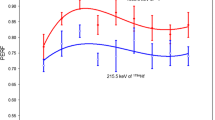Abstract
Epithermal instrumental neutron activation analysis (EINAA) has been used to determine the iodine content of many individual food materials that constitute the typical Libyan diet. The selected samples include different varieties of local and imported foods such as wheat and barley products, rice, bread, legumes such as chick peas and lentil, table salt, and commonly used spices, including thyme and fenugreek. Both conventional and anticoincidence γ-ray spectrometry techniques have been employed. Epithermal INAA in conjunction with anticoincidence counting has been found to provide the most reliable results. For quality control purposes, a number of NIST biological reference materials were analyzed. The range of daily dietary intake has been calculated as 100–180 μg of iodine per day, which is within the recommended range. Bread was identified as a significant source of iodine in the Libyan diet, as it contributed 99 μg/d.
Similar content being viewed by others
References
World Health Organization, Trace Elements in Human Nutrition and Health, WHO, Geneva (1996).
World Health Organization, Iodine Status Worldwide: WHO Global Database on Iodine Deficiency, WHO, Geneva (2004).
E.J. Underwood, Trace Elements in Human and Animal Nutrition, 4th ed., Academic, New York (1977).
R. R. Rao, J. Holzbecher, and A. Chatt, Epithermal instrumental neutron activation analysis of biological reference materials for iodine, Fresenius J. Anal. Chem. 352(1–2), 53–57 (1995).
P. Unak, F. Y. Lambrecht, F. Z. Biber, S. Teksoz, P. Eriskin, and N. Kansu, Iodine determination in milk by isotope dilution analysis, J. Radioanal. Nucl. Chem. 259(2), 321–324 (2004).
M. V. Frontasyeva and E. Steinnes, International Symposium on Harmonization of Health Related Environmental Measurements Using Nuclear and Isotopic Techniques, IAEA, Vienna (1997).
R. R. Rao and A. Chatt, Microwave acid digestion and preconcentration neutron activation analysis of biological and diet samples for iodine. Anal. Chem. 63, 1298–1303 (1991).
M. Dermeli, Z. Slekovec, A. R. Byrne, P. Stegner, V. Stibilj, and M. Rossbach, Iodine in different food articles and standard reference materials. Fresenius J. Anal. Chem. 338, 559–561 (1990).
R. R. Rao and A. Chatt, Determination of nanogram amounts of iodine in foods by radiochemical neutron activation analysis, Analyst 118, 1247–1251 (1993).
H. S. Dang, D. D. Jaiswal, and S. Nair, A comparison of three activation analysis methods for iodine determination in foodstuffs, J. Radioanal. Nucl. Chem. 249(1), 61–65 (2001).
J. Kucera, G. V. Iyengar, Z. Randa, and R. M. Parr, Determination of iodine in Asian diets by epithermal and radioanalytical neutron activation analysis, J. Radioanal. Nucl. Chem. 259(3), 505–509 (2004).
X. Hou, C. Chai, Q. Qian, C. Li, and K. Wang, Determination of bromine and iodine in biological and environmental materials using epithermal neutron activation analysis, Fresenius J. Anal. Chem. 357(8), 1106–1110 (1997).
Y. Serfor-Armah, B. J. B. Nyarko, J. Holzbecher, E. H. K. Akaho, E. K. Osae, and A. Chatt, Epithermal instrumental neutron activation analysis with Compton suppression spectrometry for the determination of iodine in food samples. J. Radioanal. Nucl. Chem. 256(2) 259–262 (2003).
V. Singh and A. N. Garg, Availability of essential trace elements in Indian cereals, vegetables and spices using INAA and the contribution of spices to daily dietary intake, Food Chem. 94(1), 81–89 (2006).
X. Hou, C. Chai, Q. Qian, G. Liu, Y. Zhang, and K. Wang, The study of iodine in Chinese total diets, Sci. Total Environ. 193, 161–167 (1997).
Walter Mertz, Trace Elements in Human and Animal Nutrition, 5th ed., Academic New York (1986).
Food and Nutrition Board, National Research Council, Recommendation Dietary Allowances, 10th ed., National Academy Press, Washington, DC (1989).
V. Chavasit, P. Malaivongse, and K. Judprasong, Study on stability of iodine in iodated salt by use of different cooking model conditions, J. Food Compos. Anal., 15(3), 265–276 (2002).
L. L. Diosady, J. O. Alberti, M. G. Venkatesh Mannar, and S. Fitz Gerald, Stability of iodine in iodized salt used for correction of iodine-deficiency disorder II, Food Nutr. Bull. 19(3), 240–250 (1998).
The World Health Organization (WHO), Guidelines for the Study of Dietary Intake of Chemical Contents, WHO offset publication No. 87:20, WHO, Geneva, pp. 20–30 (1985).
P. W. F. Fischer and A. Giroux, Iodine content of a representative Canadian diet, J. Can. Diet. Assoc. 48(1), 24–27 (1987).
R. M. Parr, N. K. Aras, and G. V. Iyengar, Dietary intakes of essential trace elements: Results from total diet studies supported by the IAEA, in 8th International Conference on Nuclear Analytical Methods in the Life Sciences, Rio de Janeiro, Brazil, 17–22 April 2005.
A. G. Gharib, A. A. Aminpour, and A. Ahmadiniar, Simulation of Iranian total mixed diets and their analysis for essential and toxic trace elements using nuclear and complementary analytical techniques, J. Radioanal. Nucl. Chem. 249(1), 47–60 (2001).
G. V. Iyengar, H. Kawamura, R. M. Parr, et al., Dietary intake of essential minor and trace elements from Asian diets, Food Nutr. Bull. 23(3) (Suppl.), 124–128 (2002).
P. Akhter, K. ur-Rehman, S. Din Orfi, and N. Ahmad, Assessment of iodine level in the Pakistani diet, Nutrition 20(9), 783–787 (2004).
V. Stibilj, L. Pograjc, C. Hlastan Ribic, et al., Se and I content in military total diet, in International Conference on Isotopic and Nuclear Analysis Techniques for Health and Environment Vienna, 10–13 June 2003.
M. Haldimann, A. Alt, A. Blanc, and K. Blondean, Iodine content of food groups, J. Food Compos. Anal. 18, 461–471 (2005).
G. V. Iyengar, W. R. Wolf, J. T. Tanner, and E. R. Morris, Content of minor and trace elements and organic nutrients in representative mixed total diet composites from the USA, Sci. Total Environ. 256, 215–226 (2000).
M. Rose, P. Miller, M. Baxter, G. Appleton, H. Crews, and M. Croasdale, Bromine and iodine in 1997 UK total diet study samples, J Environ. Monit. 3(4), 361–365 (2001).
Author information
Authors and Affiliations
Rights and permissions
About this article
Cite this article
El-Ghawi, U.M., Al-Sadeq, A.A. Determination of iodine in Libyan food samples using epithermal instrumental neutron activation analysis. Biol Trace Elem Res 111, 31–40 (2006). https://doi.org/10.1385/BTER:111:1:31
Received:
Revised:
Accepted:
Issue Date:
DOI: https://doi.org/10.1385/BTER:111:1:31




